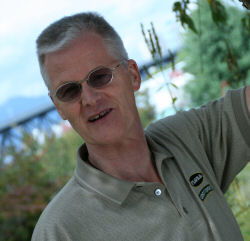|
Taken from the Holistic Times
The Newsletter of Clayton College of Natural Health
Volume 12 Number 3
 On TV talk shows, the international lecture circuit, and countless
telephone consultations, Udo Erasmus is a fat-talking man.
He feeds
each audience a feast of fats and figures and fat-astic new findings. For more than two decades, his fat-finding mission has taught
nutritionists, neighbors, physicians, and a growing mass of followers
about the good, the bad, and the ugly fats.
His ground-breaking first book, Fats and Oils, mushroomed into
what many consider the definitive text on essential fatty acids:
Fats That Heal Fats That Kill.
In its upcoming 16th reprinting, his big fat book still points a pudgy finger at industry carelessness
and gives guidelines on how to get back to living in line with
nature.
Careless food processing robs nutrients from our food supply
and creates toxic molecules, he says. The gut-wrenching result
is a world whose population is malnourished, toxic, obese, and
ill.
Dr. Erasmus has spent more than 20 years
immersed in oils: developing methods for making oils with health life rather than
shelf life in mind; introducing flax oil and ultimately refining
it into Udo’s
Oil, a proprietary blend containing all the things we need from fats
and nothing that we don’t. He offered to serve up some holistic
kitchen table wisdom from his home office in Vancouver, British
Columbia.
HT: What are the bad fats that we should eat less of?
UE: There
are three main kinds of bad fats: white fats include
hydrogenated margarine, shortening, and partially hydrogenated
vegetable oils;  burned fats are fried oils and the foods prepared
(damaged, burned, blackened) by frying; and white oils are cooking
oils whose nutrients are leached or ruined by treatment with corrosive
sodium hydroxide, harsh phosphoric acid, rancidity-causing bleaching
clays, and oildamaging high temperature deodorization. This harsh
processing, used to make most of our oils, removes beneficial molecules
like phytosterols, antioxidants and lecithin. The end product is
unbalanced oil. But even worse, this processing also damages millions
of molecules, rendering the oils toxic. burned fats are fried oils and the foods prepared
(damaged, burned, blackened) by frying; and white oils are cooking
oils whose nutrients are leached or ruined by treatment with corrosive
sodium hydroxide, harsh phosphoric acid, rancidity-causing bleaching
clays, and oildamaging high temperature deodorization. This harsh
processing, used to make most of our oils, removes beneficial molecules
like phytosterols, antioxidants and lecithin. The end product is
unbalanced oil. But even worse, this processing also damages millions
of molecules, rendering the oils toxic.
All oils in stores except extra virgin olive and oils labeled “unrefined” have
been treated that way. These are what I call the white oils. Consumption
of white oils is associated with inflammation, cancer, and cardiovascular
disease.
HT: For decades nutrition consultants have steered their clients
away from white sugar and white flour. It seems that removing white
oils and white fats from the diet has not had nearly the attention
it deserves.
UE: The
white lie is an optimistic notion that willpower alone is enough
to make enlightened choices. The truth is, in order to
grasp what’s really at stake, we need good information to
direct all of our choices, all of the time, in the direction of
health.
HT: What should practitioners recommend instead of damaged cooking
oils?
UE: To
improve health, we need to avoid the damaged fats and eat more
undamaged good fats.  To remain undamaged, good fats must be
made without preservatives, which requires great care. Good fats
deserve this care. Health requires and deserves this care. Good
fats should come from organically grown seeds and nuts, so that
they are free of pesticides. To remain undamaged, good fats must be
made without preservatives, which requires great care. Good fats
deserve this care. Health requires and deserves this care. Good
fats should come from organically grown seeds and nuts, so that
they are free of pesticides.
Good fats should contain both essential fatty acids—omega-3
and omega-6 [omega 3 and omega 6]— in 2:1 ratio and omega-3 and omega-6
should both be undamaged. Good fats should also be richer in the
omega-3 essential fatty acid (alpha-linolenic acid, ALA). Between 95–99%
of the population gets too little omega-3: at 16% of the already inadequate
intake since more than a century ago, omega-3 insufficiency is the
single most wide-spread essential nutrient deficiency of our time.
HT: What happens when people don’t
get enough omega-3?
UE: Omega-3
is essential, and “essential” has a special
meaning in nutrition. Essential is any nutrient that the body cannot
make, but must have, and therefore must obtain from food.  Essential
also means that too little leads to defi- ciency symptoms that
are degenerative in nature, get worse with time, and too little
for too long leads to death. Essential means that if enough of
an essential nutrient is returned to the diet, then all the deficiency
symptoms arising from too little of that nutrient are reversed. Essential
also means that too little leads to defi- ciency symptoms that
are degenerative in nature, get worse with time, and too little
for too long leads to death. Essential means that if enough of
an essential nutrient is returned to the diet, then all the deficiency
symptoms arising from too little of that nutrient are reversed.
Our innate intelligence knows exactly where to take these and
how to use them to build healthy bodies—if enough of the
essential nutrient is made available to the body.
Research over the past 20 years has shown that increasing omega-3
intake improves virtually every major degenerative disease of our
time. This means all of the degenerative diseases that improve
by increasing omega-3 in the diet must be, at least in part, caused
by omega-3 deficiency. That’s because omega-3 can only reverse what
is caused by omega-3 deficiency. Omega-3 will not reverse magnesium deficiency
or vitamin C deficiency, only omega-3 deficiency. The implications
here for health are enormous.
HT: The benefits of omega-3 cover the entire body,
because every cell, tissue, gland, and organ requires omega-3 for normal
function, and optimum omega-3 intake for optimum health. UE: That’s right. From cancer to CV factors, both types of
diabetes, bone strength, skin health, energy level, brain function,
mood, learning, concentration, sleep, inflammatory conditions,
autoimmune conditions, weight maintenance (by increasing fat burning
in the body), liver and kidney function, digestion, hair and nail
health, hormone function including menstrual tension, oxygen metabolism,
connective tissue health, and healing of injuries. both types of
diabetes, bone strength, skin health, energy level, brain function,
mood, learning, concentration, sleep, inflammatory conditions,
autoimmune conditions, weight maintenance (by increasing fat burning
in the body), liver and kidney function, digestion, hair and nail
health, hormone function including menstrual tension, oxygen metabolism,
connective tissue health, and healing of injuries.
HT: How much is optimum? UE: That
depends on what form of omega-3 you use, and how much the oil is
omega-3. After I wrote Fats and Oils I developed flax oil, which
contains almost 60% ALA and is therefore the richest source of
omega-3 available to us, but contains only about 15% omega-6 (4:1 ratio
of omega-3 to omega-6). I later became omega-6 defi- cient on this oil, and
thereafter developed a blend that contains about 50% ALA and 25%
LA (2:1 ratio of omega-3 to omega-6). That’s what I use today.
I recommend 1 teaspoon/day as a minimum and 1 tablespoon/ 50 pounds
of body weight/day as optimum for non-athletes. Athletes take as
much as twice the optimum.
HT: Either way, isn’t that a lot of
oil? UE: People
consume two or three tablespoons of oil per day in normal food
use, based on the fear that they will get fat. Overweight
simply comes from eating more carbohydrates than we burn.
Good fats actually help us lose fat, because they turn on the
body’s fat-burning mechanisms. Omega-3s, which are too low in
most people’s diets, turn on fat-burning most effectively,
and we use them for weight management all the time. We lower carb
intake and increase oil blend intake to increase energy, and turn
on fat burning in the body. Then we get them active. The fat just
melts off people when they do this.
Oils are major nutrients. It would be a big mistake to limit daily
oil consumption to a few capsules of fish, flax, evening primrose,
or other oil. A person would not obtain enough oil for the body’s
requirement, even if it is a very good oil. Like protein, carbohydrates,
greens, and water, we need oil in quantities of several tablespoons
rather than in pills or capsules.
HT: How much oil do you use every day?
UE: By
experimenting, I found that my daily optimum is 4 tablespoons
of my oil blend.  This equals 2 ounces (56 grams) of oil and, at
nine calories per gram, makes up about 504 calories or about 25%
of my daily calories. This equals 2 ounces (56 grams) of oil and, at
nine calories per gram, makes up about 504 calories or about 25%
of my daily calories.
I add the oil blend to foods after they come off the fire, but
never use it for frying, as frying does great damage to good fats.
Other than that, the oil blend is compatible with all foods. It’s
great for hot soup, steamed veggies, pasta sauce, and mashed potatoes
after these hot foods have been served, which cools them down.
It’s good in salad dressings, mixed into veggie or fruit
juices, yogurt, cottage cheese, protein shakes or apple sauce (apple
sauce disguises the oil remarkably well). The good fats enhance
flavors and improve the absorption of oilsoluble nutrients from
our foods.
HT: Is it true that the body cannot convert the seed oil omega-3 (ALA)
to the fish oil omega-3 fats EPA and DHA?
UE: That’s what I’ve called a fishy fish story. When
I began to work with seed oil omega-3 fats 20 years ago, I often heard
that the body is unable to convert the seed omega-3, ALA to fish n-
3s, EPA and DHA. But after spending six years researching fats
for my Ph.D., it turns out the only thing on which critics agree
is that some human bodies may be unable to convert enough ALA to
EPA and DHA.
HT: Which is to say that these critics are hedging
their hedge with another hedge.  UE: All
of which is pure speculation! (Laughs) In fact, all human populations are genetically able to produce
the enzymes necessary for the conversion to take place. The Hindu
culture is vegetarian, eats no fish or fish oils, and other than
small amounts of clabbered milk used for its content of probiotics,
eats no animal foods at all. Yet their brains contain just as much
DHA as that of fish eaters. And their vision, another indicator,
is just as good. Sperm requires DHA for fertility, and a DHA-poor
diet would result in people who are deaf, blind and sterile. They
would not reproduce, and their genes would be lost from the gene
pool. UE: All
of which is pure speculation! (Laughs) In fact, all human populations are genetically able to produce
the enzymes necessary for the conversion to take place. The Hindu
culture is vegetarian, eats no fish or fish oils, and other than
small amounts of clabbered milk used for its content of probiotics,
eats no animal foods at all. Yet their brains contain just as much
DHA as that of fish eaters. And their vision, another indicator,
is just as good. Sperm requires DHA for fertility, and a DHA-poor
diet would result in people who are deaf, blind and sterile. They
would not reproduce, and their genes would be lost from the gene
pool.
HT: Are there nutritional factors that increase
or decrease the body’s ability to convert ALA to EPA and
DHA?
UE: That’s
a key question. Several nutritional factors affect conversion rate and
efficiency. Conversion is improved by:
- Keeping omega-3/omega-6 ratio high.
- The presence of phytosterols in the oil.
- The presence of GLA in the oil.
- Low levels of omega-6, monounsaturated, saturated, and trans fats
(including CLA) in the diet.
- Lower daily intake of carbohydrates to the daily amount expended,
and
- shift to higher levels of protein in the diet, as well as
- greens
and good fats, to make sure that enough starting material (ALA)
is supplied. Most people get far too little. Omega-3 is our most widespread
essential nutrient deficiency.
“Oily science need not be a slippery slope,” the Fat
Man concludes, “and good information
can certainly help make our choices easier. In the face of so many
toxic food processes, admittedly it can be quite challenging to
live in line with nature. Nonetheless it is essential to do so.” 
|

